Why should the American Left keep an eye on the Puerto Rican election of 2024?
9 Minute Read
by Edgardo M. Roman Afanador
The American Left should keep an eye on the November 2024 Puerto Rican election because no matter the results, it will be historic. For the first time, the Puerto Rican left could win several positions and grow to become one of the top 2 political forces. In the last gubernatorial election, the two left-wing parties, the Partido Independentista Puertorriqueño (PIP) and Movimiento Victoria Ciudadana (MVC), obtained 28% of the vote, while the conservative party won with 33%. Now, the left-wing parties are running together as Alianza (Alliance). The Alianza expects to have even more support than they did when running in competition. The chance to witness the defeat of one or both parties that represent capitalism and imperialism is not one that any leftist in the US should ignore. Like any historical event, enthusiasm for this election did not appear out of nowhere. It is the result of at least 20 years of resistance, protests, and struggles by the working people of the island. Below are figures to understand what is happening and how we got here.
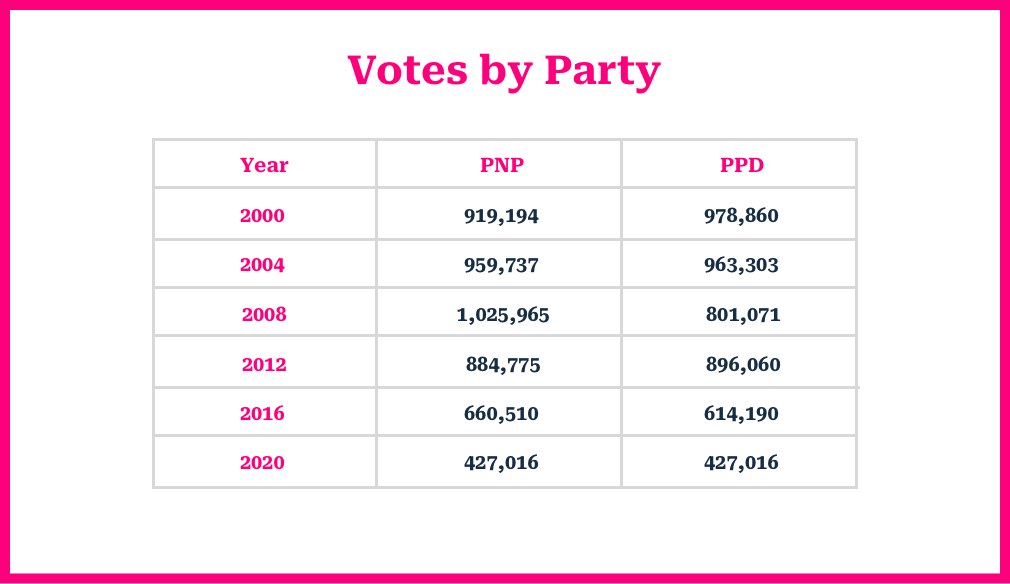
The first point is the decline of votes for the two main parties over the last 20 years. The “Partido Nuevo Progresista” (PNP) and the “Partido Popular Democratico” (PPD) have alternated power since the 60’s. Both represent the interests of American capitalism and imperialism, they are, in many ways, the equivalent of Republicans and Democrats. The chart below shows the number of votes they each received and demonstrates a reduction from nearly one million votes each in the early part of the century to less than half a million each in the 2020 election.
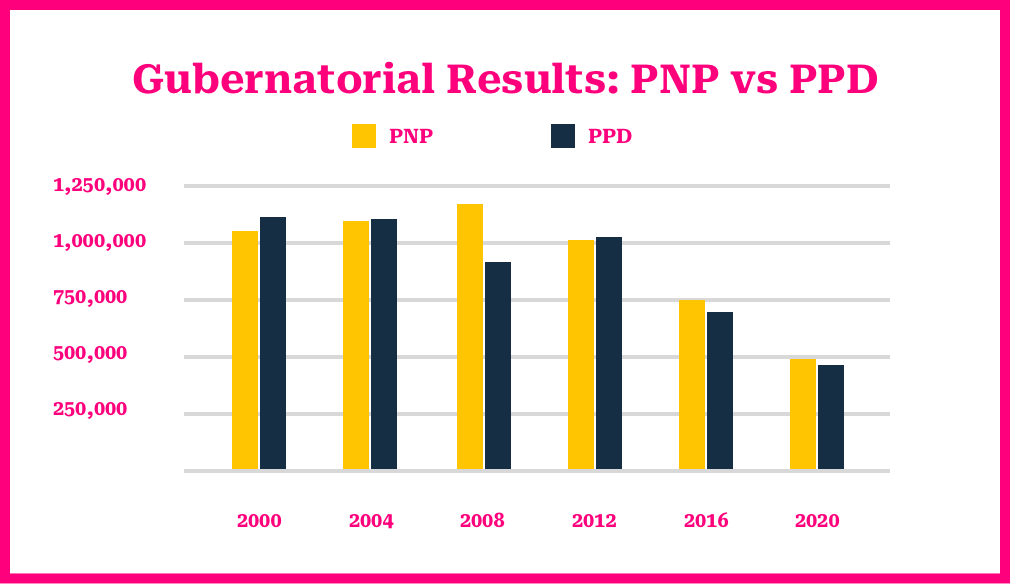
The main reason is the reduction in participation in the process. The official number of people registered to vote has not decreased, as one might have expected. On the contrary, in 2016, we saw an increase in registered people, but participation decreased from nearly 80% to 55%.
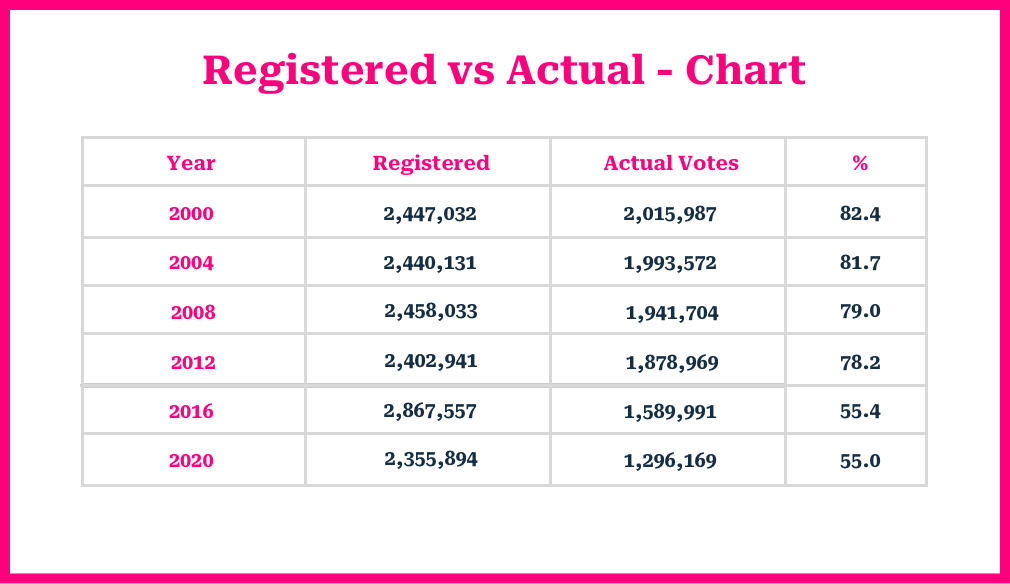
Some may claim that the reduction of votes for the two main parties and participation percentages is due to the decrease in the population (which has gone from 3.8 million in 2000 to 3.2 million in 2020) of the island and that the registered number wrongly included dead people and recent migration to the US. Hence, the actual participation number is higher than the official number. Even if this is a factor; is not the whole story. The support to the opposition parties has been growing despite the population decline. The chart below presents the results for the position of governor in Puerto Rico in this century.
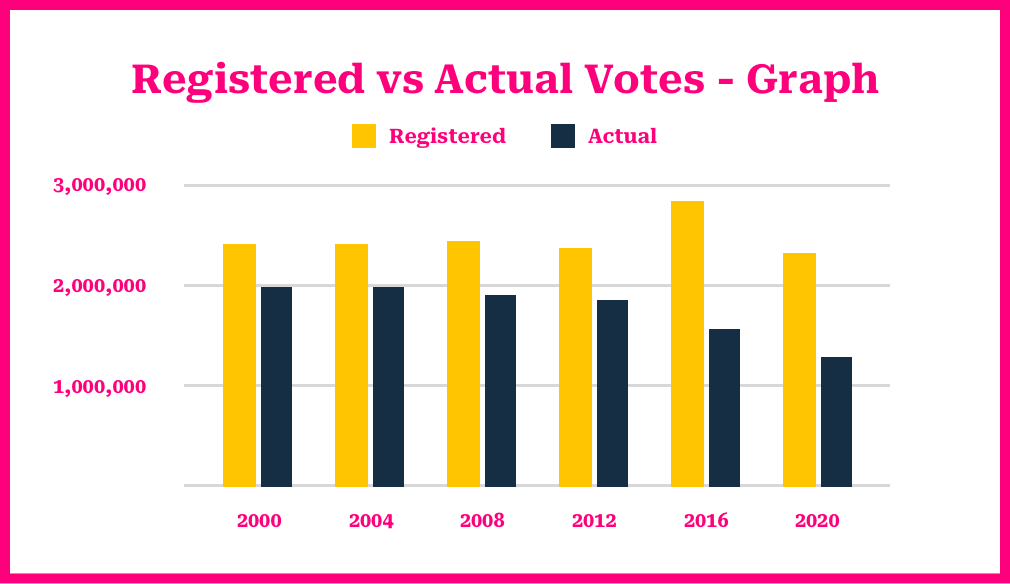
Let us review some historical events leading to our situation, starting in 2006. The legislature was PNP, the governor was PPD, and they couldn't agree on any budget for over two years. As a consequence, the government had to close for 2 weeks for the first time. The final agreement was to cave into the interest of the financial capital which we will call colloquially “Wall Street”. The governor asked for a massive loan, with unpayable terms from Wall Street, resulting in a new sales tax to pay back the loans. It began at 7%, now it is 11.5%. Since then, a massive amount of wealth has been transferred from the Puerto Rican economy to Wall Street. Thus, 2006 marked the beginning of Puerto Rico's current and ongoing economic difficulty.
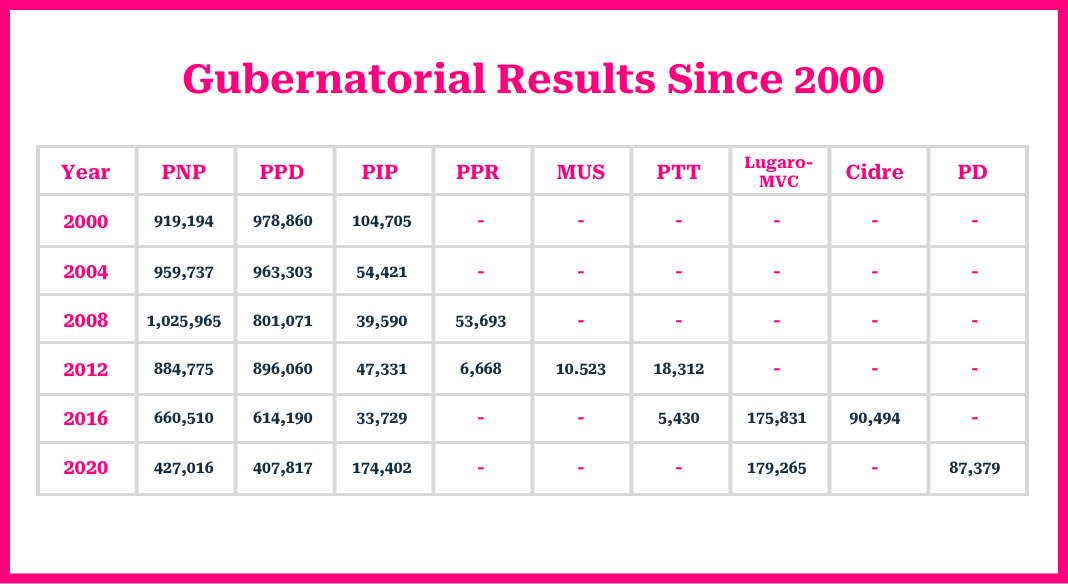
During the 2008 election, the PNP embraced completely the Wall Street ideology, promoting the privatization of public services, the layoff of public workers, the closing of schools, reducing the public funding to the university, etc. They also promised to start a process that would end in statehood. The PPD tried to play it both sides and did not reject the austerity project but did not embrace it either, their gubernatorial candidate was accused of corruption by the feds. The “Partido Independentista Puertorriqueno” (PIP), had been the third party since the 50’s, and it is the only party for the independence of Puerto Rico. It had lost a significant amount of voters in the governor race, but not as many in the legislature; the PIP senator had 90,000 votes, but this was not enough to be elected. Then, something new happened, for the first time we had another party trying to compete for power. The “Puertorriqueños por Puerto Rico” (PPR) didn't take a stand against the austerity plans imposed by Wall Street. Instead, it leaned on the message that corruption was the bigger problem, not colonialism, not austerity. While the PPR was unable to elect any legislators, and by now has effectively disappeared, their gubernatorial candidate was able to surpass the PIP candidate: opening up a world of new possibilities. They demonstrated that a relatively small group of people could present an alternative political party especially since the PIP was in an apparent decline.
The PNP won the 2008 election in a landslide; their national candidates had over a million votes marking possibly the height of the statehood movement. They won promising austerity and statehood. We got a severe austerity regime, and the start of a sequence of national referendums asking about the current status. None of these referendums have been approved or endorsed by the US Congress so they were never legally binding, making the progress of the statehood program nonexistent. What was real was the severity of the austerity program that they imposed on the country for the next four years. The people reacted with high levels of mobilizations, strikes, and protests of all sorts. At the end of these four years, we ended up with a reduction of government investment in public education, thousands of public workers lost their jobs, those who kept their jobs saw their compensation reduced, and somehow the government debt with Wall Street more than doubled, reaching 72 billion dollars.
The mobilizations during these years were so profound that they produced 2 new parties in the 2012 elections. The “Movimiento Unión Soberanista” (MUS) whose main goal was to stop the growth of the statehood movement, proposed an alliance of people who believed in independence and those who wanted more autonomy under the US. They got 10,000 votes (or half a percentage) and wouldn't try again. The second new party was “Partido del Pueblo Trabajador“ (PTT) whose main goal was to appeal to the thousands of people protesting the austerity measures during the previous years, even if they didn't believe in independence or socialism. They gained 18,000 votes (around 1 %). Even though these two new parties were competing with PIP, they actually increased their votes to 47,000, and the candidate for the senate of PIP increased to 138,000 votes. The PPD candidate for governor promised to stop the austerity program and pay the debt in full, while the PNP embraced it even further. At this point, the alignment between the PNP and the republican party was basically complete. Just like 8 years before, the PPD won the gubernatorial seat but lost every other prominent position to the PNP.
Even though the elected PPD governor promised to stop the austerity program, he didn’t. In the next 4 years (2012-2016), we saw an increase of the sales tax from 7% to the current 11.5%, and again part of those taxes were paid directly to a new loan with even worse terms than before. Funding was severely cut for public schools and universities, and public workers lost even more economic rights like holiday pay, sick leave, vacations, etc. All the austerity measures were done to avoid being unable to pay the public debt, and all was for nothing. In 2015, the governor declared that Puerto Rico could not keep making its debt payments and begged the US to intervene and create a legal process equivalent to a private bankruptcy.
The US did create a legal framework to deal with the situation in the summer of 2016. Chief Justice John Roberts assigned Judge Laura Taylor Swain to oversee all debt litigation until it was done in 2022. During this time (2016-2022) Puerto Rico didn't pay any of its debts. In exchange, the US imposed 2 significant conditions. First, they created a board of 7 people that would “supervise” every decision made by the governor and legislature of Puerto Rico. Second, was the immediate privatization of the electrical grid. Since then, this board and judge have been imposing the austerity program even when the governor and legislators did not completely agree. And a private company called LUMA has been pocketing all the money the people paid to fix and upgrade the electrical grid. All of this happened right in the middle of the campaign season for 2016.
The 2016 election was the first election where the new trend was finally visible. The creation of the board was evidence of the failure of both main parties. The PNP doubled down again on defending the austerity program and criticized the creation of the board, alleging that we could pay the debt. The PPD embraced the creation of the board, alleging that there was at least a way out of the mess. Though they took first and second place, both PNP and PPD received 300,000 fewer votes than 8 years before, making the discontent with both parties more evident. However, this also appeared to affect the left-wing parties as well. The PIP and PPT both campaigned claiming that the existence of the board is in itself an affront to democracy and clear evidence of Puerto Rico’s colonial situation. Nevertheless both their gubernatorial candidates received the lowest votes in the history of each franchise, 33,000 for PIP and 5,000 for PTT. But even in their darkest moment, both had some results that were not so bad. The PTT saw 1,000 additional votes in the congressional race; and the senate candidate for PIP got 130,000, which was enough to be elected. The real surprise of this election was the proliferation and relative success of independent candidates. In the Senate, Jose Vargas got 157,000 votes, becoming the most voted-for senator that election cycle. We also had two independent candidates for governor: one progressive-leaning candidate, Alexandra Lúgaro, and a conservative one, Manuel Cidre. Cidre got 90,000 votes, while Lúgaro surprised everyone with an astonishing 175,000 votes.
The 4-year term of 2016-2020 had several significant developments. It was the first term that the board actually governed. As expected, the austerity program came hard on the island once more. Deeper cuts for public education meant the rise of the cost per credit of the public university system, and the closure of schools. Privatizing the electric grid came with the defeat of the workers union, one of the strongest unions in Puerto Rican history. Still, it also came with the increasing cost for regular homes and the decline of the service (the amount of blackouts increased significantly). In political terms, 3 significant events changed the landscape toward the 2020 election. First, the union between Alexandra Lugaro, PTT, MUS, and some PPD members, led to a new political party called “Movimiento Victoria Ciudadana” (MVC). Second, the passing of 2 hurricanes in 2017, Irma and Maria, which unmasked the lack of investment in the transportation and logistic systems and the electric grid, an unintended consequence of the redistribution of wealth from the Island to Wall Street. The estimates are over 4,000 deaths related to the hurricanes. Most of the deaths were not caused by winds, landslides, or floods. Instead, people died in hospitals that lacked electricity and doctors could not operate, people died from minor injuries because the roads were obstructed for too long, and couldn't reach help. People died waiting for the insulin cargo that took too long due to logistics and supply issues, and at least 2 people died of hunger. At the end of the process, it was clear that this was not a natural disaster but a man-made one. The third (and maybe the most important) event happened during the summer of 2019: the Ricky Renuncia protests. The failure of the government handling of the aftermath of the hurricanes, combined with the evident corruption in handling the relief effort, and a lack of empathy of the governor and his closest allies, created a political explosion incarnated in the mobilization of hundreds of thousands of people protesting daily until the governor had no option but to resign. In those days, we saw the most extensive mobilization in the history of Puerto Rico. Although it wasn’t a revolution, it had revolutionary elements, and it's the main reason for the results of the 2020 election.
The 2020 election results are undoubtedly the best performance for the left-wing parties in the current century. The PNP and PPD again were first and second place, but now with less than half the votes of what each party had in 2008. The newly formed MVC party with Lugaro as their gubernatorial candidate got 179,000 votes, an increase of 5,000 from her previous race as an independent candidate. The big surprise this time was that the PIP candidate got 174,000 votes, making it the largest number of votes a PIP candidate ever received. But not everything was good news. Like in many other countries, Puerto Rico is also seeing the rise of an ultra-right-wing Christian nationalist political movement called “Proyecto Dignidad” (PD). Their candidate got 87,000 votes which has mixed interpretations. On the one hand, these votes are most likely taken from the PNP. On the other hand, the fact that they are organizing themselves into their own party, and not just a wing inside the PNP, is evidence of their growth. The legislator's results were similar; with one PIP candidate and 2 MVC candidates (and one from PD) entering the House and the Senate. Probably the biggest surprise was in the election of the mayor of San Juan, where the PNP won by less than 4,000 votes against the MVC candidate.
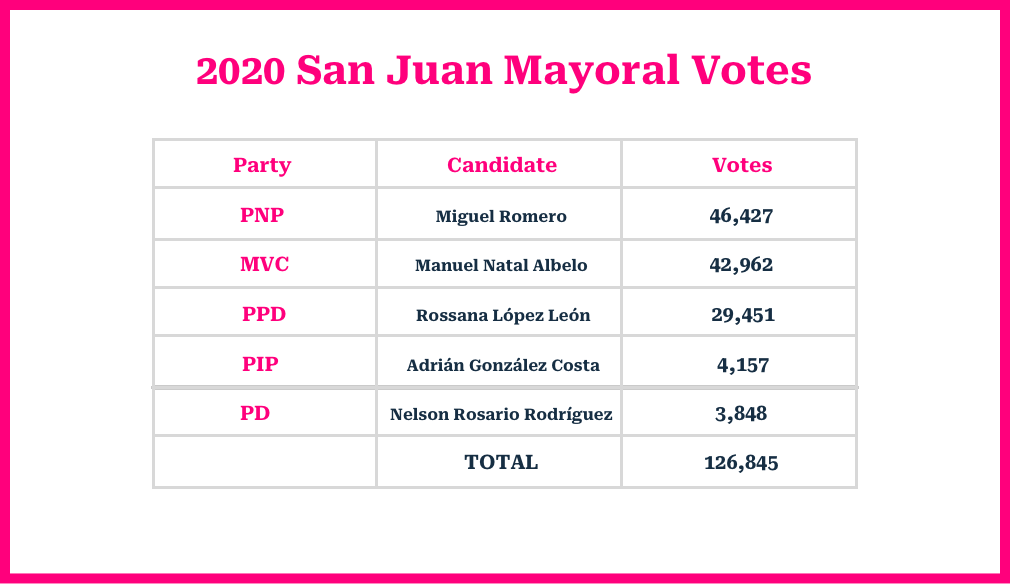
The result of the 2020 election was like a political earthquake that established the framework of the agenda for each political party for 2024. The PNP is aspiring to become the sole main party, defender of all US interests including colonial capitalism, their strategy can be represented by the metaphor of the carrot and the stick. The carrot being the false promise of statehood, and the stick is the fear of all we could lose if Puerto Rico becomes an independent nation. The PPD is doing and saying anything they can to avoid fading into irrelevance. Like the Democrats in the US, they want to be against both fascism and communism But at every turn, they support the fascists. The PD has been consistent with its message, they only exist as a reaction to the rise of the left-wing mobilizations of the recent decades, or as an attempt to legitimize its “anti-gender ideology” agenda. In a historic move, both left-wing parties PIP and MVC are running together as an alliance, and we expect: 1) an increase of gubernatorial votes, a higher percentage of votes would be a victory, but getting second place would be historic, 2) having more left-wing legislators in both chambers and 3) a leftist to win the mayoral race in San Juan.
In conclusion, just like in the US, the electoral process in Puerto Rico has been kidnapped by two parties that, even with their differences, represent the interests of the capitalist class. Just like in the US, both parties have been losing support. Just like in the US, in Puerto Rico, there is a political ecosystem trying to advance the interest of the working class inside and outside the electoral process. Just like in cities like Seattle or Chicago before, now Puerto Rico has a left in their local congress. So, why should the American Left keep an eye on this? Because there is a lot to learn from each other, or even better: help each other. Unlike the US, Puerto Rico has seen some success with their left-wing parties independent of the two mainstream parties, which could provide much-needed lessons for the US left.
Edgardo M. Roman Afanador is a Puerto Rican activist who has been involved in the fight for independence and Socialism. He participated in the student movement as part of Union de Juventudes Socialistas from Movimiento Socialista de Trabajadores in Puerto Rico. Edgardo migrated to the US 7 years ago and has continued the fight for independence in the diaspora. Edgardo's articles in Spanish can be found on Bandera.org.